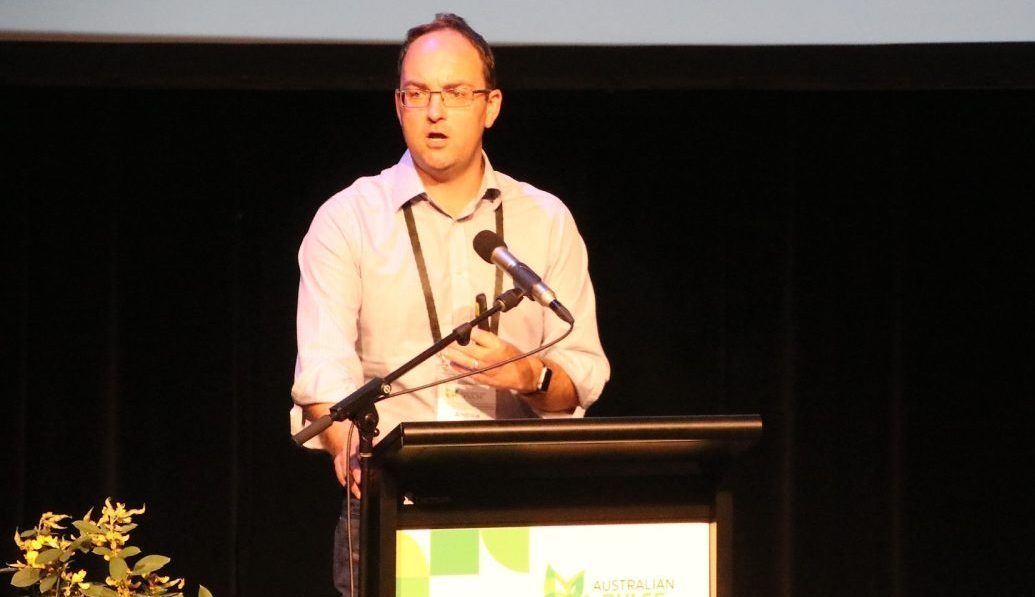
Unigrain Co-CEO Andrew May said pulse protein was on a long path to being “an overnight success”.
AUSTRALIA needs a targeted, gradual approach to developing the pulse-protein industry, according to Unigrain co-CEO Andrew May.
Unigrain is currently constructing Australia’s second pulse fractionation plant, which will become the country’s only dry processing facility.
The company has also launched a line of of plant proteins, starches and flours which will be made from faba beans, red lentils and peas such as yellow field peas and chickpeas.
Mr May told the Australian Pulse Conference this week that focusing on key pulses such as faba beans and field peas would help to streamline research, innovation and processing capacity.
Price still king
He said in terms of marketing pulse-protein ingredients, price was still the most important factor for local manufacturers if they were going to switch suppliers from leaders Estonia or China to Australia.
“We’ve got to be really clear that Australia has to be careful not to over-invest in things that we’re not going to be able to compete in, because it still comes back to price,” Mr May said.
“Provenance and sustainability will only get us so far; the ingredients still have to be price effective.”
He said customers are not willing to pay two-four times more for an Australian product, but would be open to a price difference of 10-20pc if the ingredients are locally delivered and there are opportunities to work with growers on traceability and sustainability.
Mr May said price was driven by which pulses were the most efficiently transformed into protein ingredients, and had strong customer demand.
He said Australia has that advantage with faba beans and, to a lesser extent, field peas.
He predicted that protein production could take 30-40pc of the Australian faba bean and field pea crop, most of which was currently exported in bulk.
“There’s no reason why Australia cannot lead the way in the world in terms of innovation in faba bean and distribution of faba bean ingredients.
“Let’s play in this space really heavily.
“Lentils, I think is just too big…and I probably see that as more peripheral as well as chickpea, probably just because they’re a much more expensive ingredient.”
However, with chickpeas, Mr May said Australia “can differentiate ourselves in the market” if the industry was able to innovate and develop different processing or variety options.
He said this could offer greater market opportunities, but chickpeas were still likely to remain a niche protein ingredient.
Possible grower gains
Mr May said increasing the percentage of pulses that went into value-added markets would have flow-on benefits for growers.
“Definitely for field peas and faba beans, I think we’re of the view that this portion of the market can really help with dealing with some of the volatility.
“We know in the yellow pea market in Victoria, if a few of the main pea buyers are not buying them, the price can fall out pretty quickly.”
He said the industry could not promise that pulses would skyrocket in value, but “we certainly think it can help reduce risk for growers”.
Scope for protein scale
An integral part of helping the pulse-protein industry reach its potential will be due to work undertaken by plant breeders, agronomists and researchers, according to Mr May.
“Right now in Australia, we have very, very little knowledge of what drives the differential for the differing levels of protein across pulses.
“There’s a lot of work to be done in terms of building up that baseline…level of knowledge for the market.”
He said, unlike other customers, pulse processors “don’t care whether the bean is aesthetically beautiful or is big”.
“So I see over time…in yellow pea, and with faba beans, that we’ll end up with probably some kind of difference in quality standards and we will be buying pulses on the basis of their protein content.
“For this portion of the market, change is going to be needed…in terms of what the focus for breeding and agronomic practices needs to be.”
More than meat
Mr May said the pulse-protein industry and plant breeders and researchers had to have a wider view of how the ingredients can be transformed into consumer goods.
“The market is much bigger than alternative meat.
“There’s a lot of discussion about the hype of it, the expectations, how fast is it growing…but we’ve got to think way more broadly.
“Plant protein can go in so many different kinds of products: bakery snack, cereals, additives, beverages.
“The one that is really relevant for Australia is pet food.”
Mr May said the protein mix in grain-free pet food featured a “good portion of pulse protein”.
“There is a big scope for the market.
“The opportunity, we think, over the next couple of decades is enormous, but we need to be mindful that it is a long road.
“Our view is it will happen more gradually than suddenly, that it’ll be an overnight success that takes 15 years to get there.”
Unigrain currently runs a cereal ingredient-processing plant at Smeaton, north of Ballarat.
Alongside constructing a pulse fractionation facility, the company is also building an oat milk-base processing plant.
Unigrain also has a mill at Wagin in the Western Australian grainbelt, where oats are processed, and lupins go into its feedmill.
The company was formed in the 1970s through the merging of Bill May’s WD Seeds, and Costa Group’s Southern Cross Grains.
Unigrain is still jointly owned by the May family, including Bill’s children Andrew and Fiona, the Unigrain co-CEOs, and the Costa family.
Grain Central: Get our free news straight to your inbox – Click here



HAVE YOUR SAY